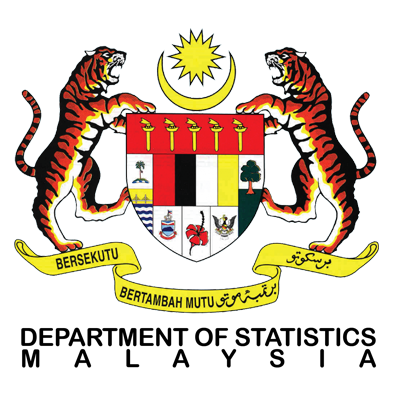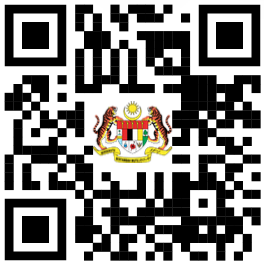Malaysia External Trade Statistics
- Home
- Statistics
- Economy
- External Sector
- Malaysia External Trade Statistics
Malaysia External Trade Statistics April 2020
Malaysia External Trade Statistics March 2020 3 April 2020
Malaysia External Trade Statistics February 2020 4 March 2020
Malaysia External Trade Statistics January 2020 4 February 2020
Malaysia External Trade December Statistics 2019 3 January 2020
Malaysia External Trade Statistics November 2019 4 December 2019
Malaysia External Trade Statistics October 2019 Show all release archives
Overview

KEY FACTS
MONTHLY
- Malaysia’s exports in April 2020, registered a decline of 23.8% to RM64.9 billion year-on-year (y-o-y) which was the largest decline since September 2009 during the global financial crisis in 2009. The decrease was due to most of the sectors of national economies have been shut down since March 18, 2020 to slow down the spread of the COVID-19 pandemic. Re-exports was valued at RM18.6 billion registering an increase of 38.2% y-o-y and accounted for 28.7% of total exports. However, domestic exports decreased 35.4% or RM25.4 billion to RM46.3 billion.
- Imports also registered a decrease of 8.0% y-o-y to RM68.4 billion. In April 2020, Malaysia’s imports exceeded the value of its exports due to the imports of floating structures from Republic of Korea which was valued at RM10.1 billion.
- On a month-on-month (m-o-m) basis, exports declined 19.0% from RM80.1 billion. In seasonally adjusted terms, exports shrank 15.4%.
- On a m-o-m basis, imports expanded 0.9% from RM67.8 billion. In seasonally adjusted terms, imports grew 4.9%.
- On a y-o-y basis, exports fell due to the decrease in exports to the European Union (-RM2.7 billion), the United States (-RM2.4 billion), India
(-RM2.3 billion), Singapore (-RM2.0 billion) and Thailand (-RM2.0 billion). However, exports increased to China (+RM488.1 million). - On a y-o-y basis, lower imports were mainly from Singapore (-RM2.5 billion), the European Union (-RM2.1 billion), Thailand (-RM1.7 billion), Saudi Arabia (-RM1.6 billion) and Japan (-RM906.9 million). Meanwhile, higher imports were from Republic of Korea (+RM9.9 billion).
TRADE
Total trade which was valued at RM133.3 billion decreased RM26.2 billion or 16.4% compared to April 2019. It also posted a decrease of RM14.6 billion or 9.9% when compared to March 2020. The trade deficit in April 2020 was valued at RM3.5 billion. This was the first month of trade deficit since October 1997.
EXPORTS
On a y-o-y basis, exports decreased 23.8% to RM64.9 billion. All main products recorded decreases.
- Electrical and electronic (E&E) products (39.9% of total exports), shrank RM7.2 billion (-21.7%) to RM25.9 billion;
- Refined petroleum products, which accounted for 7.6% of total exports declined RM1.4 billion or 22.2% to RM5.0 billion due to the decrease in average unit value (-37.3%) despite the export volume rose 24.0%;
- Timber and timber-based products, which contributed 1.4% to total exports, decreased RM891.9 million or 49.6% to RM906.9 million;
- Liquefied natural gas (LNG), which accounted for 4.4% of total exports declined RM737.6 million or 20.5% to RM2.9 billion due to the decrease in both export volume (-18.3%) and average unit value (-2.8%);
- Crude petroleum (1.9% of total exports) contracted RM639.8 million or 33.8% to RM1.3 billion due to the decrease in both average unit value (-26.5%) and export volume (-10.0%);
- Palm oil and palm oil-based products (7.8% of total exports), registered a decrease of RM126.5 million (-2.4%) to RM5.0 billion. Exports of palm oil, the major commodity in this group of products declined RM48.5 million or 1.6% due to the decline in export volume (-19.5%) despite the average unit value increased 22.3%; and
- Natural rubber which accounted for 0.4% of total exports, decreased RM91.0 million or 27.2% to RM243.9 million due to the lower in export volume(-27.4%) despite the average unit value rose 0.3%.
On a m-o-m basis, exports also declined RM15.2 billion (-19.0%) from RM80.1 billion. All main products recorded decreases.
- Refined petroleum products declined RM2.2 billion or 31.0% from RM7.2 billion due to the decrease in both average unit value (-24.7%) and export volume (-8.3%);
- Crude petroleum dropped RM1.1 billion or 45.6% from RM2.3 billion due to the decrease in both export volume (-33.4%) and average unit value (-18.4%);
- E&E products declined RM979.0 million (-3.6%) from RM26.9 billion;
- Timber and timber-based products decreased RM683.6 million (-43.0%) from RM1.6 billion;
- LNG declined RM494.7 million (-14.8%) from RM3.4 billion due to the decrease in export volume (-14.9%) even though average unit value increased 0.1%;
- Palm oil and palm oil-based products declined RM331.7 million or 6.2% from RM5.4 billion. Exports of palm oil decreased RM15.6 million or 0.5% due to the decline in average unit value (-5.4%) despite the export volume increased 5.2%; and
- Natural rubber dropped RM32.4 million or 11.7% from RM276.3 million due to the decline in both export volume (-10.2%) and average unit value (-1.7%).
Exports to Country of Destination
The two major destinations for Malaysia’s exports in April 2020 were China and Singapore.
Exports to China which was valued at RM12.1 billion increased RM488.1 million (+4.2%). The main products that attributed to the increment were:
- Iron and steel bars, rods, angles, shapes and sections (including sheet piling), increased RM672.5 million; and
- E&E products increased RM187.5 million (+4.4%) to RM4.5 billion.
However, exports of iron ore and concentrates declined RM334.0 million (-96.1%) to RM13.4 million. Exports of LNG also dropped RM166.1 million (-22.0%) to
RM588.5 million.
In April 2020, exports to Singapore amounted RM10.1 billion, declined RM2.0 billion or 16.3% as compared to the previous year. The main products which attributed to the decrease were:
- Crude petroleum decreased RM508.2 million (-90.2%) to RM54.9 million;
- E&E products declined RM370.8 million (-6.9%) to RM5.0 billion; and
- Jewellery, goldsmiths' and silversmiths' wares and other articles of precious or semi- precious materials declined RM199.0 million (-99.9%) to RM0.1 million.
However, exports of refined petroleum products increased RM375.1 million or 22.1% to RM2.1 billion.
Seasonally Adjusted Figure
On a m-o-m basis seasonally adjusted terms, exports fell RM11.8 billion (-15.4%) to RM64.9 billion.
Exports, 2016-2020

IMPORTS
On a y-o-y basis, imports declined RM5.9 billion or 8.0% to RM68.4 billion. The decrease in imports by end use was contributed by intermediate goods and consumption goods.
- Intermediate Goods
In April 2020, total imports of intermediate goods which constituted 41.3% of total imports, declined RM12.5 billion (-30.6%) to RM28.3 billion. The decrease was mainly attributed to part & accessories of capital goods (except transport equipment) (-RM4.9 billion, -44.0%), industrial supplies, processed (-RM4.4 billion, -25.3%), fuel & lubricants, primary (-RM2.3 billion, -58.0%) and parts & accessories of transport equipment (-RM989.1 million, -37.7%).
- Consumption Goods
Imports of consumption goods which constituted 8.5% of total imports, declined RM793.5 million (-12.0%) to RM5.8 billion. The decline was mainly attributed to durables (-RM581.6 million, -61.0%), non-durables (-RM162.4 million, -10.0%) and food & beverages, processed, mainly of household consumption (-RM55.6 million, -3.0%).
- Capital Goods
Imports of capital goods which accounted for 21.9% of total imports, recorded an increase of RM6.1 billion (+68.9%) to RM15.0 billion. Capital goods (except transport equipment) increased by RM7.6 billion (+93.5%) to RM15.7 billion. While retained imports of transport equipment, industrial was valued at - RM743.5 million due to re-exports of this good exceeded imports.
On a m-o-m basis, imports increased RM615.4 million or 0.9% from RM67.8 billion. The increase in imports by end use was attributed to increases in capital goods.
- Capital Goods
Imports of capital goods increased by 248.1% to RM15.0 billion compared to RM4.3 billion recorded in the previous month. Imports of capital goods (except transport equipment) increased by RM9.2 billion (+141.7%) to RM15.7 billion. While retained imports of transport equipment, industrial was valued at -RM743.5 million.
- Intermediate Goods
Imports of these goods declined RM10.6 billion (-27.3%) from RM38.8 billion. The main components contributed to the decline were part & accessories of capital goods (except for transport equipment) (-RM5.2 billion, -45.5%), fuel & lubricants, primary (-RM3.0 billion, -64.7%), industrial supplies, processed (-RM1.6 billion, -11.0%) and industrial supplies, primary (-RM569.0 million, -20.8%).
- Consumption Goods
Imports of these goods declined RM480.0 million (-7.6%) from RM6.3 billion. The decline was due to food & beverages, processed, mainly for household consumption (-RM263.2 million, -12.9%), durables (-RM200.4 million, -35.0%) and food & beverages, primary, mainly for household consumption (-RM196.2 million, -17.9%). However, imports of semi-durables rose RM223.0 million (+21.7%).
Imports by Country of Origin
The two main sources of Malaysia’s import in April 2020 were China and Republic of Korea.
Imports from China which was valued at RM14.2 billion declined RM901.1 million (-6.0%) when compared to April 2019. The main products which contributed to the decline were:
- Motor cars and other motor vehicles for the transport of persons shrank RM335.6 million or 90.7% to RM34.5 million;
- Aluminium (including alloys) declined RM211.8 million or 55.6% to RM169.4 million;
- Musical instruments and parts and accessories decreased RM141.0 million or 71.2% to RM56.9 million; and
- Telecommunications equipments, their parts, and accessories fell RM138.1 million (-14.0%) to RM850.8 million.
Imports from Republic of Korea which registered RM13.0 billion recorded an increase of RM9.9 billion or 323.9% from a year ago. The increment was attributed to the import of floating structures which was valued at RM10.1 billion.
Seasonally Adjusted Figure
On a m-o-m basis seasonally adjusted terms, imports increased RM3.4 billion (+4.9%) to RM71.7 billion.
Imports, 2016-2020

MARKET SHARE
The following charts show Malaysia's major trading partners for January - April 2020.
Total Trade by Major Countries, Jan – Apr 2020, percentage share

Exports and Imports by Major Countries, Jan – Apr 2020, percentage share

The following charts show Malaysia’s trade with ASEAN countries for January - April 2020.
Exports, Jan – Apr 2020, percentage share

Imports, Jan – Apr 2020, percentage share

#Notes:
1. The April 2020 data is provisional and subject to revision in later issues.
2. This report can be accessed through the web portal of the Department of Statistics, Malaysia (https://www.dosm.gov.my) under section: Latest Release.
Released By:
DATO' SRI DR. MOHD UZIR MAHIDIN
CHIEF STATISTICIAN MALAYSIA
DEPARTMENT OF STATISTICS, MALAYSIA
![]() DrUzir_Mahidin
DrUzir_Mahidin ![]()
![]() Dr_Uzir
Dr_Uzir
4 JUNE 2020
Contact person:
Mohd Yusrizal Ab Razak
Public Relation Officer
Strategic Communication and International Division
Department of Statistics, Malaysia
Tel : +603-8885 7942
Fax : +603-8888 9248
E-mail : yusrizal.razak[at]dosm.gov.my
Subscribe
Newsletter
Subscribe to our newsletter and stay updated
For interviews, press statement and clarification to the media, contact:
Baharudin Mohamad
Public Relation Officer
Email: baharudin[at]dosm.gov.my
Phone: 03 8090 4681
Not found what you looking for? Request data from us, through
Go to eStatistik
Email: data[at]dosm.gov.my
Phone: 03 8885 7128 (data request)










